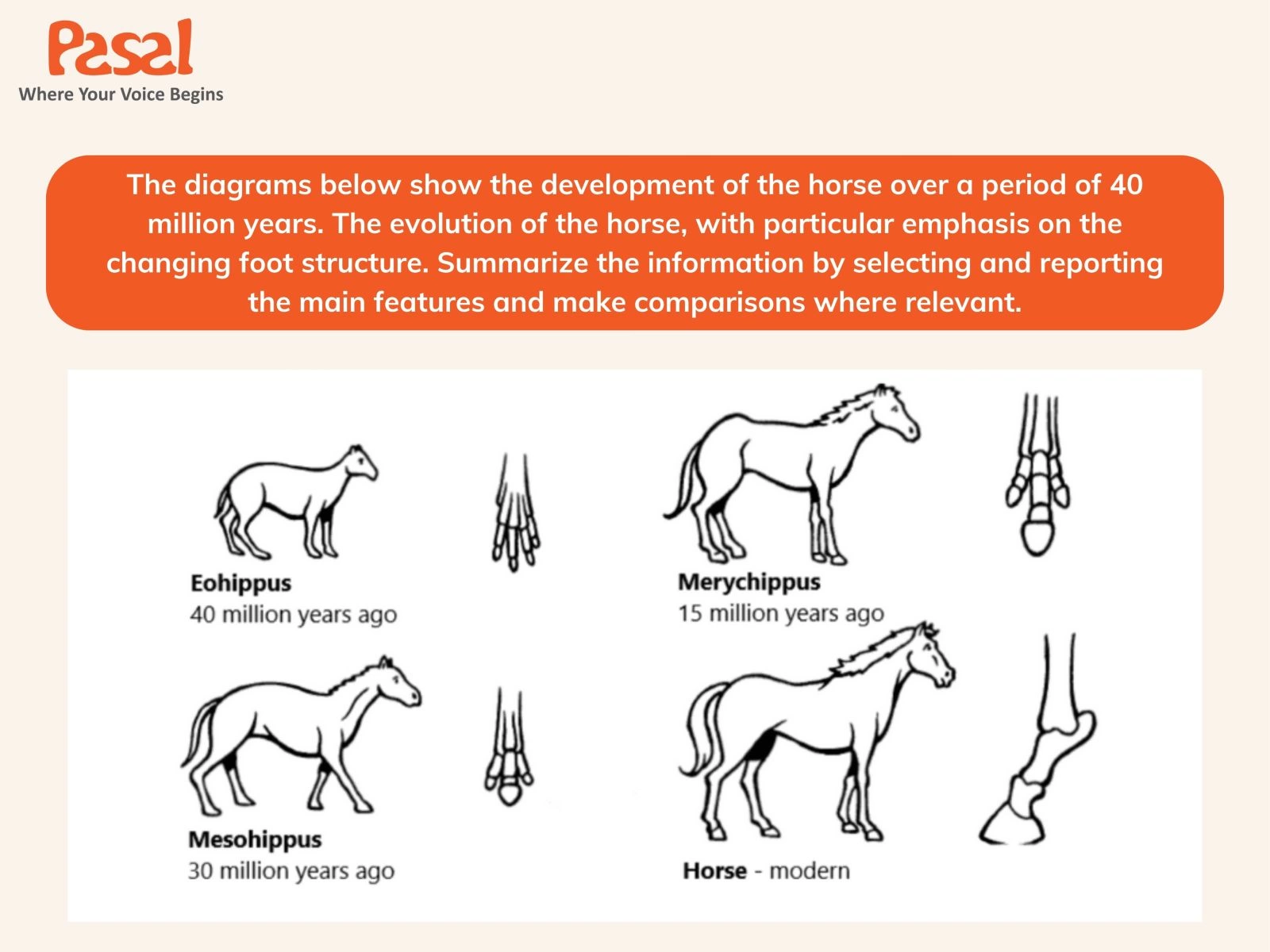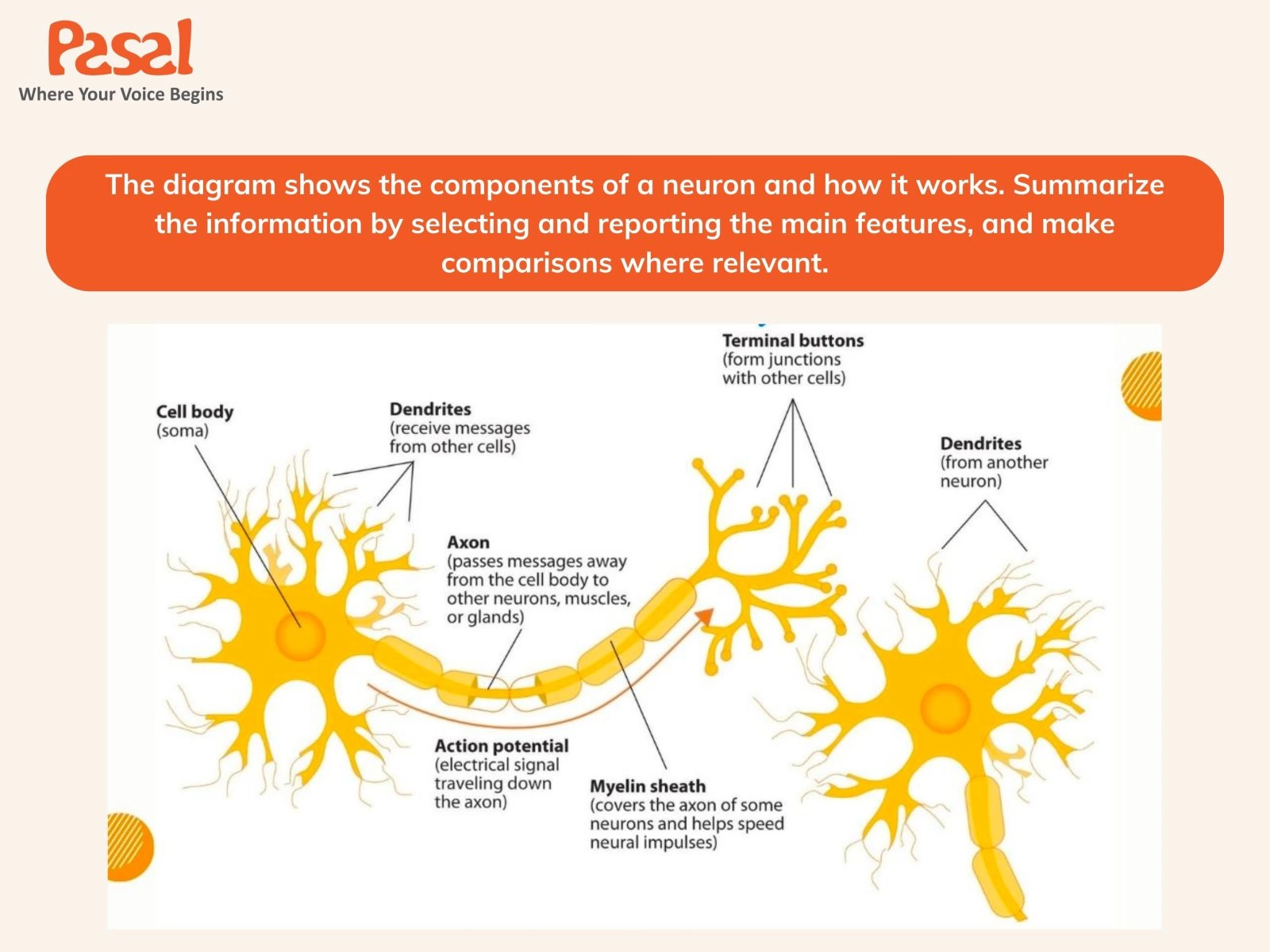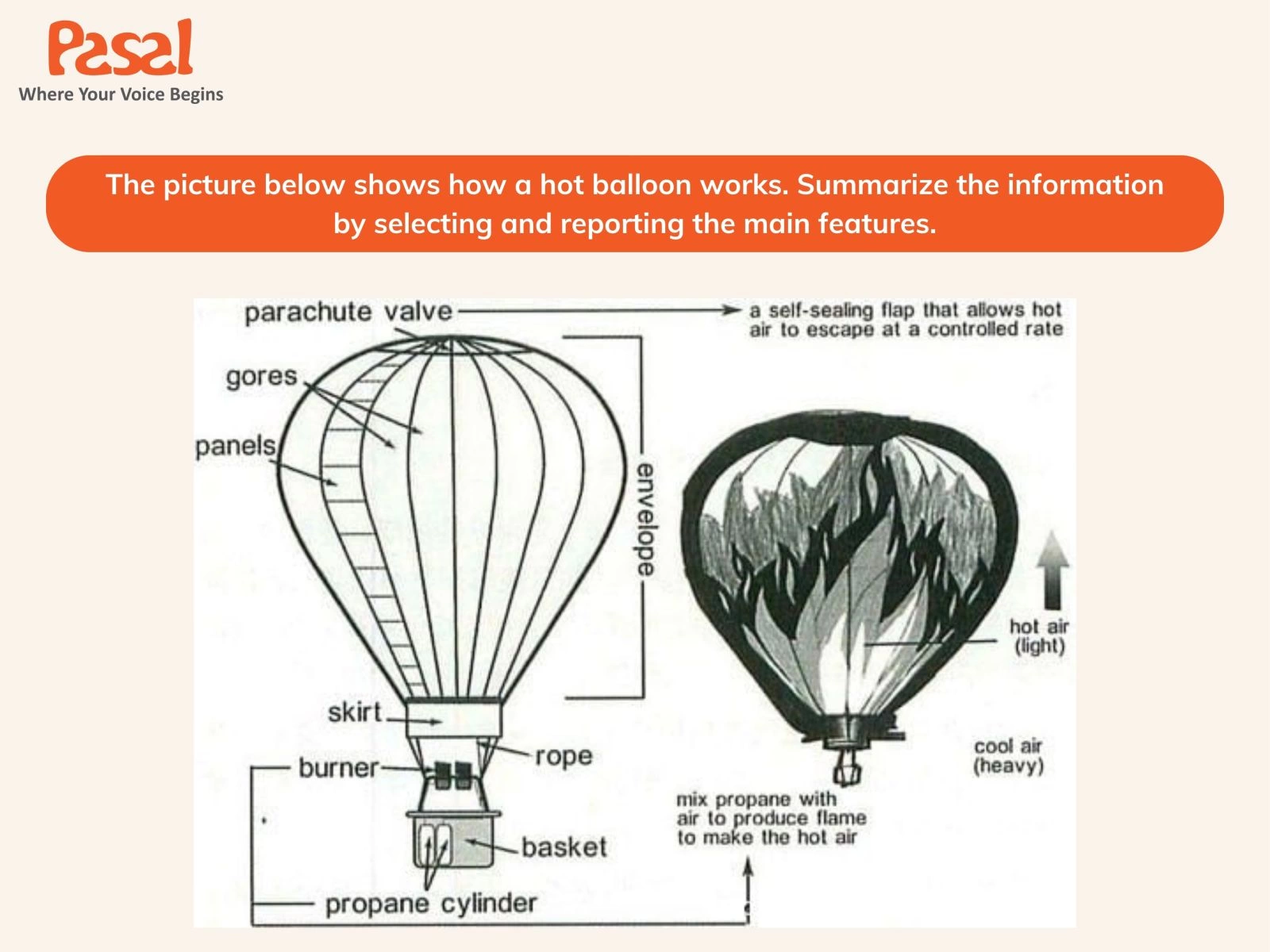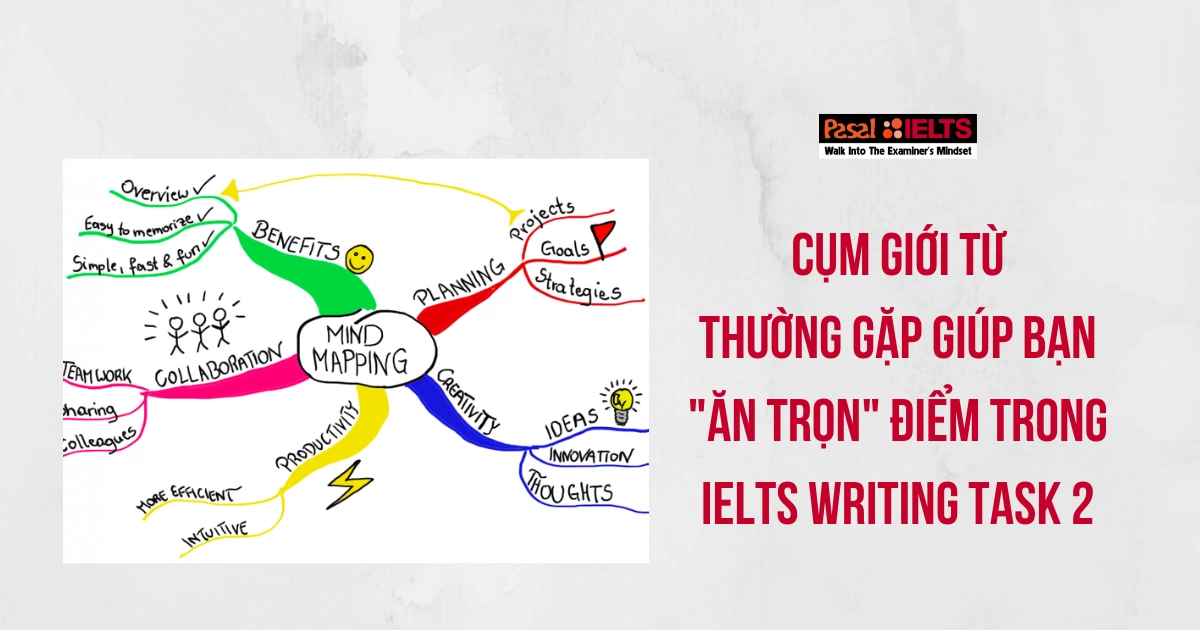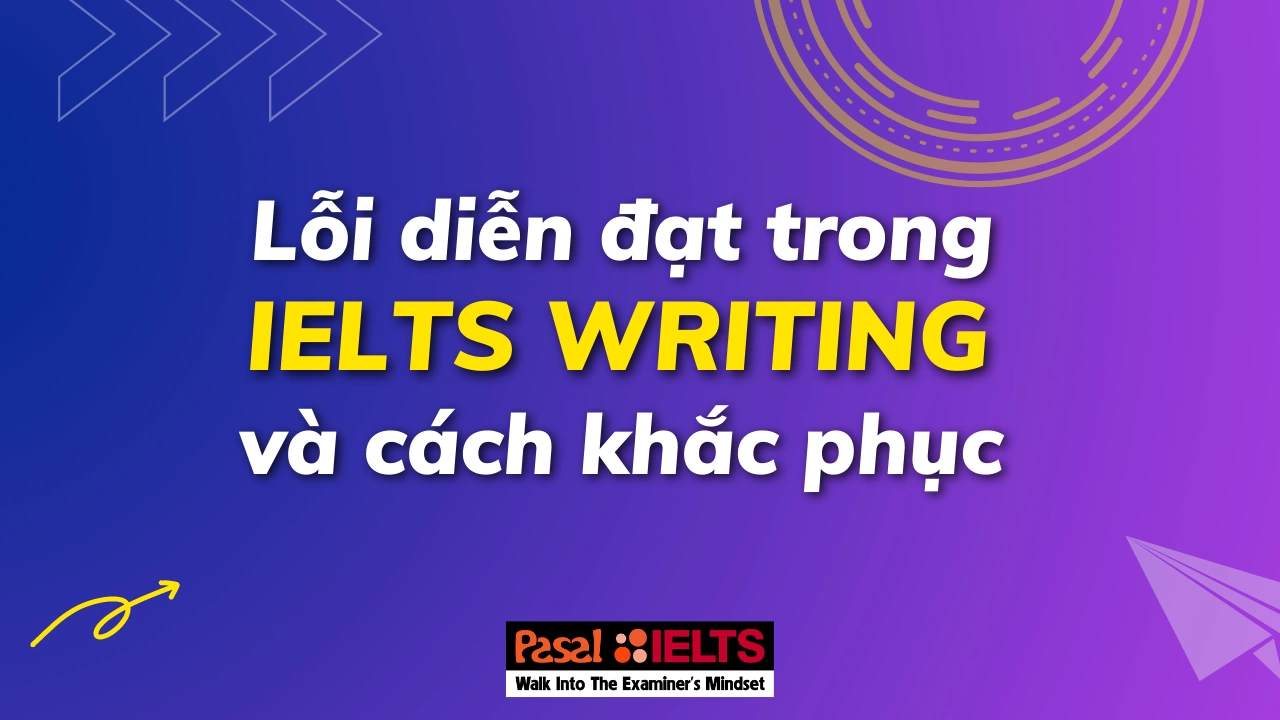Tổng hợp 16 đề IELTS Writing task 1 Process lạ, khó kèm lời giải chi tiết
Nhắc đến IELTS Writing, chắc hẳn bạn thí sinh nào cũng đều sợ dạng bài Process. Mặc dù dạng bài này không quá thường xuyên xuất hiện trong đề thi nhưng nếu chẳng may gặp phải mà không có sự chuẩn bị trước thì chắc chắn sẽ khó được điểm cao. Trong bài viết này, hãy cùng Pasal khám phá lời giải chi tiết của 16 đề IELTS Writing Task 1 Process khó và lạ nhé!
Đề IELTS Writing Task 1 Process: Quá trình tiến hoá của ngựa
Đề bài: The diagrams below show the development of the horse over a period of 40 million years. The evolution of the horse, with particular emphasis on the changing foot structure. Summarize the information by selecting and reporting the main features and make comparisons where relevant.
1.1. Phân tích đề và từ vựng
Các bạn cần lưu ý rằng, điều quan trọng nhất trong việc xử lý các đề IELTS Writing task 1 lạ và khó như thế này chính là khâu chuẩn bị, không chỉ về mặt cấu trúc mà cả vốn từ vựng đa dạng nữa.
Với mỗi đề IELTS Writing task 1, các bạn cần nắm được Core Vocabulary (từ ngữ lõi) liên quan đến chủ đề của bài đó.
Dưới đây là Core Vocabulary của đề “Vó ngựa huỷ diệt”:
-
Hoof (n): móng guốc
-
Evolution (n): sự tiến hóa
-
Development/ Evolve (v): tiến hóa
-
Reminiscent (adj): hồi tưởng
Sau khi chuẩn bị 1 số từ vựng nâng cao, chúng ta cùng nhau phân tích đề nhé:
-
Ở đây, chúng ta có thể phân tích khá dễ dàng rằng bức tranh này miêu tả sự tiến hóa của cả con ngựa và cả móng guốc của nó trong suốt 40 triệu năm, vậy chúng ta có thể phân chia thành 2 yếu tố phải miêu tả: con ngựa và cái móng của nó.
-
Lưu ý rằng, đừng cố sa đà vào việc phân tích và chỉ ra điểm khác nhau giữa các móng guốc với nhau, vì càng sa đà vào ngôn ngữ phân tích (Analyze Writing Language), các bạn sẽ càng bí từ. Thay vào đó, hãy miêu tả bằng cách trực quan bằng ngôn ngữ miêu tả (Descriptive Language).
-
Trước hết, về mặt con ngựa, chúng ta có thể nhìn thấy rõ ràng rằng qua thời gian, con ngựa càng ngày càng to, đến hiện tại, con ngựa to gần gấp đôi so với 40 triệu năm trước, vì thế chúng ta có thể dùng 1 chút ngôn ngữ so sánh để chỉ ra sự thay đổi về kích cỡ của con ngựa qua thời gian, phần sử dụng ngôn ngữ so sánh thì khá đơn giản rồi (kiến thức cơ bản của các bài Writing task 1).
Phần khó của bài này nằm ở phần chúng ta phải phân tích cái phần móng ngựa phía bên phải và ghép chúng với từng mốc thời gian. Ở đây, chúng ta sẽ cùng phân tích nhanh một chút cho từng mốc thời gian nhé:
-
Eohippus: multi-toed (similar to primate’s hand)
-
Mesohippus: three toes with the middle one looking like the modern hoof
-
Merychippus: the foot slowly becomes the hoof
-
Horse: evolve completely into the hoof
1.2. Cấu trúc bài viết
Sau khi phân tích kĩ càng được bài viết, chúng ta hoàn toàn có thể phân chia cấu trúc của bài này thành 3 phần sau
-
Đoạn 1: Introduction (bao gồm 2 câu: Paraphrase và Overview Statement)
-
Đoạn 2: Body 1 (3-4 câu: Miêu tả và so sánh cả con ngựa cùng với các mốc thời gian)
-
Đoạn 3: Body 2 (3-4 câu: Miêu tả và so sánh móng con ngựa cùng các tên gọi theo các mốc thời gian)
1.3. Sample answer
The given diagrams illustrate the development of the horse over the 40 million years’ time period.
Overall, it is observable that the species have doubled in size, especially the foot has completely changed its structure from being five-toed to being a hoof.
Despite the differences in size of the Eohippus compared directly to the modern horse or the prior species such as Mesohippus and Merychippus, the overall structure of the horse (including head, body, tail, and neck) resents some similarities. But the most observable evolution that worth mentioning is the fact that the horse has evolved from the size of a domestical goat to a full-sized modern horse after 40 million years.
The foot itself has evolved dramatically from 40 million years ago being multi-toed, not dissimilar to a primate’s hand perhaps, to converting to three toes 10 million years later, with the central one being slightly reminiscent of a modern hoof, though much smaller. Then only minor changes had happened up to 15 million years back before the foot became the hoof that is so familiar up to now, consisting of a single rounded protective outer bone structure with a radically different lower leg bone arrangement, now having only 4 bones, which supports the greatly increased load. (209 words)
Đề IELTS Writing Task 1 Process: Sự phát triển của công cụ đồ đá
Đề bài: The diagram below shows the development of cutting tools in the Stone Age. Summarise the information by selecting and reporting the main features, and make comparisons where relevant.
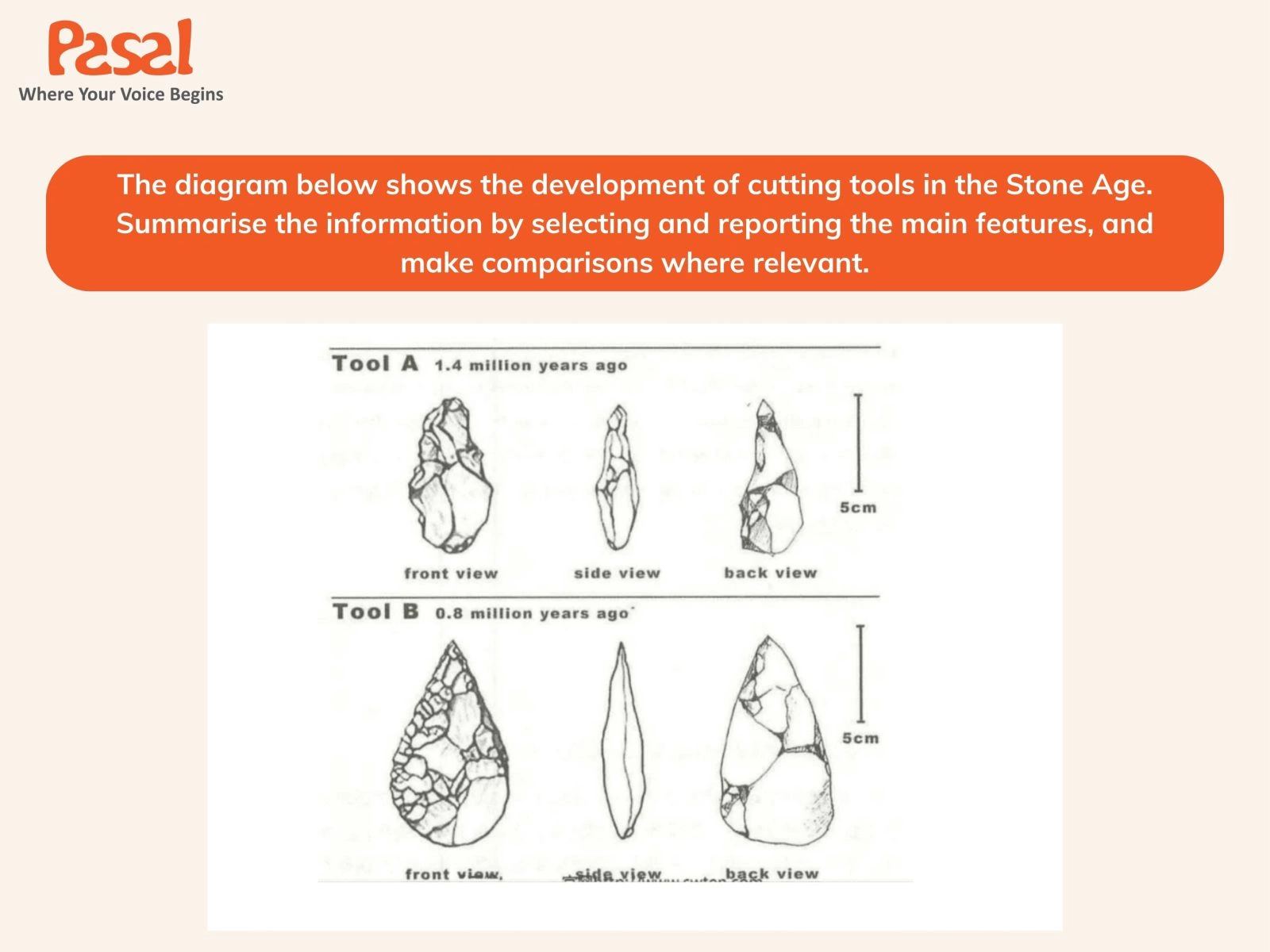
2.1. Phân tích đề và từ vựng
Trước hết để nhìn nhận một cách trực quan, 2 đoạn Body Paragraphs (thân bài) của bài này thật sự rất dễ chia khi mốc thời gian đã được chia sẵn rồi. Vậy công việc còn lại của chúng ta chỉ là tìm ra cách để miêu tả cái cục đá này thôi.
Mỗi Body Paragraph nên bao gồm từ 3-4 câu, điều này khiến việc planning sentences dành cho bài này cực kì đơn giản khi chúng ta chỉ cần miêu tả 3 tiêu chí “Front view”, “Side view” và “Back view”, mỗi tiêu chí 1 câu với phần độ dài, độ rộng là 1 supporting information là xong.
Core Vocabulary của chủ đề này bao gồm:
-
Primitive (adj): nguyên thủy
-
Improvements (n): cải tiến
-
1 số tính từ (adj) miêu tả hòn đá này: rounded, sharp, rough, refined
-
Diameter (n): đường kính
-
Tapered (v): được vót nhọn
2.2. Cấu trúc bài viết
Sau khi phân tích kĩ càng được bài viết, chúng ta hoàn toàn có thể phân chia cấu trúc của bài này thành 3 phần sau:
-
Đoạn 1: Introduction (bao gồm 2 câu: Paraphrase và Overview Statement)
-
Đoạn 2: Body 1 (3-4 câu: Miêu tả viên đá 1.4 triệu năm trước, mỗi view là 1 câu)
-
Đoạn 3: Body 2 (3-4 câu: Miêu tả Miêu tả viên đá 0.8 triệu năm trước, mỗi view là 1 câu)
2.3. Sample answer
The given diagrams demonstrate the transformation of the primitive cutting tools during the Stone Age of two different periods of time (1.4 million years ago and 800 thousand years ago).
It is clear that the same tool underwent significant improvements and turned into a sharper and much more efficient one after 600 thousand years.
It is observable that the stone tool made 1.4 million years ago was more rounded at the top and bottom edges. From the front and the back view of the tool, it is clear that the diameter in the middle was almost 5 cm, and towards the top and bottom, it was around 3cm wide. The side view shows that the tool was wider in the middle, with a diameter of approximately 3 cm, and it tapered towards the top, and the bottom ends. The back of the stone had fewer cuts than the front, and they were also not very fine.
800 thousand years ago, this tool developed into a sharper, more refined one. The front and the back view show that the maximum diameter of the tool was the same as in the older tool, but it was more towards the lower side. The bottom tapered into a 1 cm point, but the top tapered more sharply into a 1 cm point. The side view clarifies that it was much smaller in width (1.5 cm) than the older tool. The stone was more chiseled than the previous one. (254 words)
Đề IELTS Writing Task 1 Process: Cấu tạo của Neuron thần kinh
Đề bài: The diagram shows the components of a neuron and how it works. Summarize the information by selecting and reporting the main features, and make comparisons where relevant.
3.1. Phân tích đề và từ vựng
Nhìn vào đề bài này chúng ta hoàn toàn có thể luận ra ngay cách phân chia của 2 đoạn body của bài này: 1 đoạn nói về Components và 1 đoạn nói về Functions.
Tuy nhiên ở trong bài này mình sẽ viết theo phong cách tách đôi, có nghĩa rằng mình sẽ tách đôi cái sơ đồ này ra và phân tích cả Components và Functions trong cùng 1 đoạn. Bằng cách này mình sẽ tiết kiệm được vốn từ và sử dụng được nhiều từ nối hơn.
Chúng ta sẽ chia đôi dựa theo function:
-
Nửa đầu: Những bộ phận phục vụ nhiệm vụ tiếp nhận thông tin (bao gồm Cell body và Dendrites)
-
Nửa sau: Giai đoạn Action potentials để truyền thông tin (bao gồm Axon, Myelin sheath và Terminal Buttons)
-
Sau khi chia nửa Overall Function của biểu đồ này, chúng ta cùng đi sâu vào từng bộ phận để phân tích chức năng nhé.
-
Cell body (soma): Nằm ở phần lõi của neuron và được bao bọc bởi 1 hệ thống phân nhánh
-
Dendrites: nằm ở cuối hệ thống phân nhánh với nhiệm vụ tiếp nhận thông tin
-
Axon: Chuỗi thần kinh dạng ống nhằm truyền thông tin
-
Myelin shealth: Bọc bảo vệ Axon dạng con nhộng
-
Terminal buttons: Dây thần kinh dạng nhánh nằm trao đổi và kết nối với các tế bào khác
Sau khâu phân tích này thì nhiệm vụ còn lại của chúng ta đơn giản là sắp xếp lại và form 1 cấu trúc bài thôi!
3.2. Cấu trúc bài viết
Sau khi phân tích kĩ càng được bài viết, chúng ta hoàn toàn có thể phân chia cấu trúc của bài này thành 3 phần sau:
-
Đoạn 1: Introduction (bao gồm 2 câu: Paraphrase và Overview Statement)
-
Đoạn 2: Body 1 (3-4 câu: Miêu tả nửa đầu)
-
Đoạn 3: Body 2 (3-4 câu: Miêu tả nửa sau)
3.3. Sample answer
The given diagram demonstrates the form as well as the functions of a single working neuron inside our nerve system.
Overall, there are two separated parts of a neuron with two different functions, one is for receiving information from other cells and the other is reserved for spreading it.
First and foremost, the core of the cell is formed into a branching system surrounding the rounded core Cell body (also called soma). The thin nerves at the end of the branch which are called the Dendrites undertake the task of receiving and transfering information from other cells to the soma for analysis.
After the recievant process, the analyzed information is then transferred through a process called Action potential in electrical signal form. The information travels through a tube-shaped nerve named Axon which is protected by a capsule-shaped Myelin sheath into the physical system such as other neurons, muscles, or glands. By the end of the process, the flow moves to another branching system called Terminal buttons to form junctions with other cells. (172 words)
Đề IELTS Writing Task 1 Process: Hoạt động của khinh khí cầu
Đề bài: The picture below shows how a hot balloon works. Summarize the information by selecting and reporting the main features.
Sample Answer:
The picture demonstrates the general structure and floatation function of a hot air balloon.
Overall, the function of a hot balloon consists of 2 steps: rising into the air and keeping itself afloat.
The main part of a hot balloon is an enormous envelope with a body made of gores and panels. While there is a parachute valve that serves as a self-sealing flap at the top, the bottom part of the envelope is covered with a skirt that connects the envelope to a basket by several ropes. This basket contains a burner and a propane cylinder.
To make the balloon fly, a mixture of propane from a propane cylinder and the air is heated with fire to produce a flame in order to fill the hot air into the envelope. As the hot air inside is lighter than the cool air outside, the balloon flies. In order to adjust and control the height of the flying balloon, the parachute valve is sealed or unsealed to allow hot air to escape at a controlled rate. (171 words)
Tải full 16 đề IELTS Writing Task 1 Process lạ và khó
Bên cạnh đó, nếu bạn mong muốn làm bài test IELTS full 4 kỹ năng hoàn toàn miễn phí thì nhanh tay đăng ký ngay tại đây nhé:
Lời kết:
Bài viết trên đây đã tổng hợp cũng như phân tích rất chi tiết 16 đề IELTS Writing Task 1 Process lạ và khó. Pasal hy vọng rằng bài viết đã cung cấp nhiều thông tin hữu ích cho các bạn đang ôn luyện IELTS. Nếu bạn đang loay hoay với việc học IELTS thì đừng ngần ngại inbox cho Pasal để nhận tư vấn lộ trình học chi tiết nhé!

